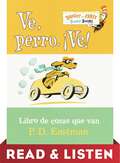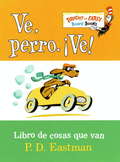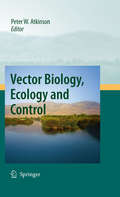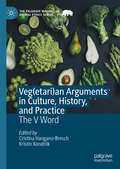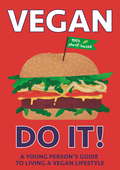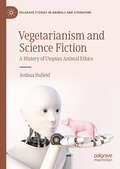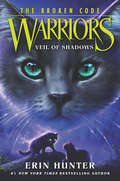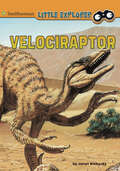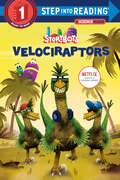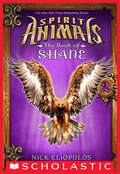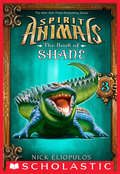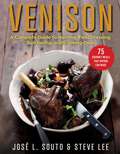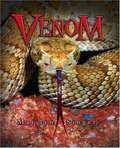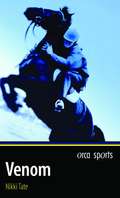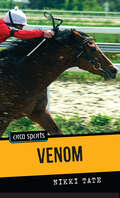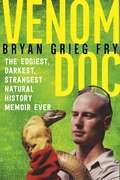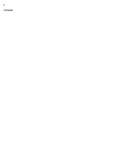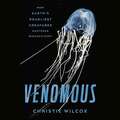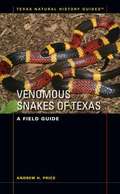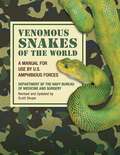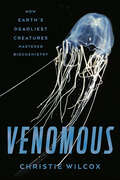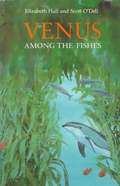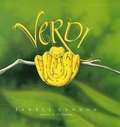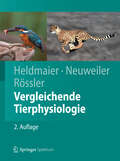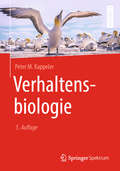- Table View
- List View
Ve, Perro. Ve! Read & Listen Edition (Bright & Early Board Books(TM))
by P.D. EastmanEl clásico libro de la serie Beginner Books, ¡disponible ahora en español! Escrito para lectores principiantes usando sólo 75 palabras, el libro cuenta con perros rojos, perros azules, perros pequeños —todas las maravillosas variedades de perros de P. D. Eastman— montando en bicicletas, scooters, esquís y patines, y conduciendo todo tipo de vehículos en camino a una gran fiesta de perros… ¡encima de un árbol!
Ve, Perro. Ve!: Go, Dog. Go! (Bright & Early Board Books(TM))
by P. D. Eastman Adolfo Perez PerdomoNow the classic Beginner Book is available in Spanish! Written for beginning readers using only 75 different words, it features red dogs, blue dogs, big dogs, little dogs--all kinds of wonderful P. D. Eastman dogs--riding bicycles, scooters, skiis, and roller skates and driving all sorts of vehicles on their way to a big dog party held on top of a tree!
Vector Biology, Ecology and Control
by Peter W. AtkinsonThe control of mosquitoes and other insect vectors of human pathogens in an area-wide, environmentally and sustainable way is critical to solving global health problems in the developing world but also to industrialized countries that already have in place efficient vector control programs. The rapid spread of West Nile virus through the United States provides one example of how even a highly developed country can be relatively powerless against the spread of mosquito-borne disease. This volume illustrates how the efforts over half a century of a single investigator, Mir S. Mulla, and his students and collaborators have achieved sustainable vector insect control in regions of the world extending from the south-western United States to south-east Asia. These control strategies have been refined over these decades and now are employed in a diversity of ecosystems. Increased public awareness of global health and the importance placed on this for the future well-being of the entire human population makes the deployment and refinement of these strategies even more timely.
Veg: The V Word (The Palgrave Macmillan Animal Ethics Series)
by Cristina Hanganu-Bresch Kristin KondrlikThis collection explores the arguments related to veg(etari)anism as they play out in the public sphere and across media, historical eras, and geographical areas. As vegan and vegetarian practices have gradually become part of mainstream culture, stemming from multiple shifts in the socio-political, cultural, and economic landscape, discursive attempts to both legitimize and delegitimize them have amplified. With 12 original chapters, this collection analyses a diverse array of these legitimating strategies, addressing the practice of veg(etari)anism through analytical methods used in rhetorical criticism and adjacent fields. Part I focuses on specific geo-cultural contexts, from early 20th century Italy, Serbia and Israel, to Islam and foundational Yoga Sutras. In Part II, the authors explore embodied experiences and legitimation strategies, in particular the political identities and ontological consequences coming from consumption of, or abstention from, meat. Part III looks at the motives, purposes and implication of veg(etari)anism as a transformative practice, from ego to eco, that should revolutionise our value hierarchies, and by extension, our futures. Offering a unique focus on the arguments at the core of the veg(etari)an debate, this collection provides an invaluable resource to scholars across a multitude of disciplines.
Vegan Do It!
by Charlotte WillisAre you vegan-curious? Vegan Do It! offers a sensible, achievable guide for any young person who is interested in adopting a vegan lifestyle.The popularity of veganism is growing fast, with millions of new people discovering a plant-based lifestyle every year. Vegan Do It! aims to support young people who are curious about trying veganism for themselves with clear, helpful information, advice and support. It explores the ethical issues that convince many to try veganism and outlines how a vegan lifestyle can benefit your health and the environment. Sensible advice features throughout, such as meal planners, how and where to source vegan products, cafes and restaurants chains that serve vegan food, while a selection of healthy, achievable recipes aim to support aspiring vegans in their daily life.Written by vegan writer and journalist, Charlotte Willis, Vegan Do It! is the perfect resource for readers aged 12 and up.
Vegetarianism and Science Fiction: A History of Utopian Animal Ethics (Palgrave Studies in Animals and Literature)
by Joshua BulleidVegetarianism and Science Fiction: A History of Utopian Animal Ethics examines how vegetarian ideals promoted within science fiction and utopian literature have had a real-world impact on the awareness and spread of vegetarianism and animal advocacy, as well as how the genres' engagements have been altered to reflect changes in ethical and environmental philosophy. Author Joshua Bulleid examines the representation of vegetarianism in the works of major science fiction authors, including Mary Shelley, H. G. Wells, Arthur C. Clarke, Philip K. Dick, Ursula K. Le Guin, Ernest Callenbach, Marge Piercy, Octavia E. Butler, Kim Stanley Robinson and Margaret Atwood within their evolving social contexts, tracing the development of vegetarian trends and their science fictional representations from the early-nineteenth century to the present day.
Veil of Shadows (Warriors: The Broken Code #3)
by Erin HunterThe #1 nationally bestselling Warriors series continues! Discover more epic adventures in the third book in the action-packed Broken Code story arc.After losing one of his nine lives, ThunderClan’s leader, Bramblestar, became intent on rooting out and exiling cats he claims are traitors to the warrior code. But some cats know the truth: this isn’t the real Bramblestar, and their leader’s true spirit is desperate to return to its rightful place before the rising tension among the five Clans erupts into outright war.Packed with action and intrigue, this sixth Warriors series is the perfect introduction for readers new to the Warriors world, while dedicated fans will be thrilled to discover the new adventures that unfold after the events of A Vision of Shadows.
Velociraptors (Step into Reading)
by Scott EmmonsThe curious crew from the Netflix series Ask the StoryBots star in an all-new Step into Reading leveled reader!Get ready to meet the rapping velociraptors. They've got pointy teeth, sharp claws, and mad rhymes. Based on a favorite StoryBots adventures, this Step 1 Science Reader will entertain boys and girls ages 4 to 6 while imparting a few fun facts about these popular carnivorous creatures.Step 1 Readers feature big type and easy words for children who know the alphabet and are eager to begin reading. Rhyme and rhythmic text is paired with picture clues to help children decode the story.
Vendetta: Special Edition) (Spirit Animals: The Book of Shane #2)
by Nick EliopulosThis trilogy of e-shorts shines a light on one of the most compelling--and dangerous--villains of the NEW YORK TIMES bestselling series. Now and then, to accomplish something great, you have to do something bad. Shane intends to end the conflict that's devastating Erdas... and to achieve that, he's just done something very bad. While returning home from a fateful victory, the young Conqueror discovers he's being pursued, and must seek cover in a war-torn jungle. But the forest holds dangers of its own, and before long Shane is fighting for his life. If he's going to win this war, Shane will need to outmaneuver a deadly pursuer -- and his own guilty conscience. Author Bio Nick Eliopulos is the author of Spirit Animals: The Book of Shane, a series of e-novellas set in the world of the bestselling multi-platform series. His short stories have appeared in Spirit Animals: Tales of the Great Beasts and Stuck in the Middle: Seventeen Comics from an Unpleasant Age. An avid fan of comics, games, and monster movies, he lives in Brooklyn and works in Manhattan as an editor of books for kids and teens.
Vengeance: Special Edition) (Spirit Animals: The Book of Shane #3)
by Nick EliopulosThis trilogy of e-shorts shines a light on one of the most compelling--and dangerous--villains of the NEW YORK TIMES bestselling series. The war is over and Erdas is rebuilding. It seems everyone is celebrating a new age of peace. Everyone except Shane. Shane wants revenge. The young Conqueror is on the hunt, tracking a target who knows his every move before it happens. He's closing in on his prey -- but the closer Shane gets, the more he begins to see patterns in the shadows. Shane can sense a trap is waiting. He's being led down a path that he may not be able to return from. Will he abandon his quest for vengeance . . . or follow it into the darkness? Author Bio Nick Eliopulos is the author of Spirit Animals: The Book of Shane, a series of e-novellas set in the world of the bestselling multi-platform series. His short stories have appeared in Spirit Animals: Tales of the Great Beasts and Stuck in the Middle: Seventeen Comics from an Unpleasant Age. An avid fan of comics, games, and monster movies, he lives in Brooklyn and works in Manhattan as an editor of books for kids and teens.
Venison: A Complete Guide to Hunting, Field Dressing and Butchering, and Cooking Deer
by Jose SoutoVenison is experiencing an unprecedented growth in popularity as a delicious, healthy, and increasingly available dish.Here are more than fifty recipes from the senior chef/lecturer in Culinary Arts at Westminster Kingsway College, England. In this beautifully illustrated volume, world-renowned chef Jose Souto has added to his own repertoire of thirty dishes by inviting guest chefs to add their own favorite venison recipes to this book, opening up a wide range of dishes, from simple venison lasagne to elegant dinner-party show-stoppers.Not just a cook book, this is a celebration of deer: stunning pictures not only depict deer in their natural habitat, but also the intricacies of the hunt, the reality of field dressing and butchering a deer once it's down, plus mouth-watering shots of venison meals on the table. Many of the shots were taken by world-famous photographer Steve Lee.
Venom
by Marilyn SingerLearn about venom and the animals that produce it and use it to survive, including spiders, insects, snakes and other reptiles, frogs and toads, fish, and ocean invertebrates.
Venom
by Nikki TateSpencer is sure someone is doping the racehorses at the stable where he works, but no one will listen to him until he gets some proof. (Orca Sports)
Venom (Orca Sports)
by Nikki TateSixteen-year-old Spencer loves his job at the local racing stable, but when he becomes convinced that someone is drugging the racehorse Lord of the Flies, no one believes him. In an effort to find out who is behind a dangerous race-fixing scheme, he takes on some of the most unsavory members of the track community. By refusing to turn a blind eye, Spencer risks losing those he cares most about, including Em, the stableowner's niece.
Venom Doc: The Edgiest, Darkest, Strangest Natural History Memoir Ever
by Bryan Grieg FrySteve Irwin meets David Attenborough in this jaw-dropping account of studying the world’s most venomous creatures. Venomologist Bryan Grieg Fry has one of the most dangerous jobs on Earth: he works with its deadliest creatures. He’s been bitten by twenty-six venomous snakes, been stung by three stingrays, and survived a near-fatal scorpion sting while deep in the Amazon jungle. He’s received more than four hundred stitches and broken twenty-three bones, including breaking his back in three places, and had to learn how to walk again. But when you research only the venom you yourself have collected, the adventures—and danger—never stop. Bryan’s discoveries have radically reshaped views on venom evolution and contributed to the creation of venom-based life-saving medications. In pursuit of venom, he has traveled the world collecting samples from Indonesia to Mexico, Germany, and Brazil. He’s encountered venomous creatures of all kinds, including the Malaysian king cobra, the Komodo dragon, and the brush-footed trapdoor spider. Bryan recounts his lifelong passion for studying the world’s most venomous creatures in this outlandish, captivating memoir, where he and danger are never far apart.
Venom: The Secrets Of Nature's Deadliest Weapon
by Ronald Jenner Eivind UndheimVenom brings readers face to face with some of the most dangerous creatures on the planet, including jellyfish, snakes, and wasps, as it uncovers the story of venom. The book explores how venom is used for predation, defense, competition, and communication by an incredible diversity of species. It examines the unique methods that these species have evolved to create and deliver their deadly toxins. The book traces venom back to its origin in early jellyfish and sea anemones, and reveals how venoms have evolved dozens of times independently all across the animal kingdom since that time. And finally, it examines the relationships between these dangerous creatures and humans. Humans have not only learned to live with them, but also to benefit from them: scientists increasingly are harnessing the power of venom to create new drugs, treatments, and anti-venoms.
Venomous
by Christie WilcoxIn Venomous, molecular biologist Christie Wilcox investigates venoms and the animals that use them, revealing how they work, what they do to the human body, and how they can revolutionize biochemistry and medicine today. <p><p> Wilcox takes us from the coast of Indonesia to the rainforests of Peru in search of the secrets of these mysterious animals. We encounter jellyfish that release microscopic venom-packed darts known to kill humans in just two minutes, a two-inch caterpillar with toxic bristles that trigger hemorrhaging throughout the body, and a stunning blue-ringed octopus with saliva capable of inducing total paralysis. How could an animal as simple as a jellyfish evolve such an intricate, deadly poison? And how can a snake possess enzymes that tear through tissue yet leave its own body unscathed? <p><p> Wilcox meets the fearless scientists who often risk their lives studying these lethal beasts to find out and puts her own life on the line to examine these species up close. Drawing on her own research on venom chemistry and evolution, she also shows how venom is helping us untangle the complex mechanisms of some of our most devastating diseases. <p><p> Venomous reveals that the animals we fear the most actually hold the keys to a deeper understanding of evolution, adaptation, and immunity. Thrilling and surprising at every turn, Venomous will change the way you think about our natural world.
Venomous Snakes of Texas
by Andrew H. PriceTexas has about one hundred twenty native species and subspecies of snakes, fifteen of which are venomous. Since 1950, Texans have turned to the Poisonous Snakes of Texas pamphlet series published by the Texas Parks and Wildlife Department for help in identifying these snakes and for expert advice on preventing and treating snakebite. Venomous Snakes of Texas, a thoroughly revised and updated edition of Poisonous Snakes, carries on this tradition as a one-stop, all-you-need-to-know guide to Texas's rattlesnakes, copperheads, cottonmouths, and coral snakes. In this authoritative field guide, you'll find:- Full-color photographs and a county-by-county distribution map for each species. - Each species' common and scientific name, description, look-alikes, and a summary sketch of its habitat, behavior, reproduction, venom characteristics, predator-prey relationships, and fossil record. - Up-to-date advice on recognizing venomous snakes and preventing and treating snakebite, both at home and in the field. - A glossary of terms and an extensive bibliography. A special feature of this guide is an expanded treatment of the ecological and evolutionary context in which venomous snakes live, which supports Price's goal "to lessen the hatred and fear and to increase the understanding, the respect, and even the appreciation with which venomous snakes should be regarded. "
Venomous Snakes of the World: A Manual for Use by U.S. Amphibious Forces
by Department of the Navy Bureau of Medicine and Surgery Scott ShupeOriginally published in 1962, and fully updated and colorized by Scott Shupe, Poisonous Snakes of the World is the perfect practical guide to not only snake bite survival, but to understand and identifying every venomous snake on the planet. Even if no life hangs in the balance, this manual is a great reference guide for the outdoors enthusiast, the reptile lover, or anyone with a thirst for pragmatic, how-to knowledge.With this comprehensive edition, you will be armed with one of the most thorough volumes available for dealing with these incredible reptiles, including definitive advice on:Precautions to avoid snake bites.Identifying the symptoms and signs of snake venom poisoning.First-Aid and medical treatments.Recognizing poisonous snakes.Indigenous species to various regions around the world.Sources of Antivenin.Snakes can be among some of the most deadly creatures on the planet. They are also extremely fascinating, and by taking the proper precautions, can be enjoyed and appreciated. From the Monocle Cobra to the Gaboon Viper, learn to fear and respect these incredible reptiles.
Venomous: How Earth's Deadliest Creatures Mastered Biochemistry
by Christie WilcoxA thrilling tale of encounters with nature’s masters of biochemistryFrom the coasts of Indonesia to the rainforests of Peru, venomous animals are everywhere—and often lurking out of sight. Humans have feared them for centuries, long considering them the assassins and pariahs of the natural world.Now, in Venomous, the biologist Christie Wilcox investigates and illuminates the animals of our nightmares, arguing that they hold the keys to a deeper understanding of evolution, adaptation, and immunity. She reveals just how venoms function and what they do to the human body. With Wilcox as our guide, we encounter a jellyfish with tentacles covered in stinging cells that can kill humans in minutes; a two-inch caterpillar with toxic bristles that trigger hemorrhaging; and a stunning blue-ringed octopus capable of inducing total paralysis. How do these animals go about their deadly work? How did they develop such intricate, potent toxins? Wilcox takes us around the world and down to the cellular level to find out. Throughout her journey, Wilcox meets the intrepid scientists who risk their lives studying these lethal beasts, as well as “self-immunizers” who deliberately expose themselves to snakebites. Along the way, she puts her own life on the line, narrowly avoiding being envenomated herself. Drawing on her own research, Wilcox explains how venom scientists are untangling the mechanisms of some of our most devastating diseases, and reports on pharmacologists who are already exploiting venoms to produce lifesaving drugs. We discover that venomous creatures are in fact keystone species that play crucial roles in their ecosystems and ours—and for this alone, they ought to be protected and appreciated.Thrilling and surprising at every turn, Venomous will change everything you thought you knew about the planet’s most dangerous animals.
Venus among the Fishes
by Scott O'Dell Elizabeth HallWhen killer whales invade Glacier Strait, Coral's herd is in deadly danger. Reluctantly, Coral's father and mother send her in search of safer waters. The journey is not easy, and Coral confronts hungry sharks, menacing killer whales, and hazardous fishing nets. Inevitably, she encounters the greatest danger of all -- humans.
Verdi
by Janell CannonYoung Verdi doesn’t want to grow up big and green. He likes his bright yellow skin and sporty stripes. Besides, all the green snakes he meets are lazy, boring, and rude. When Verdi finds a pale green stripe stretching along his whole body, he tries every trick he can think of to get rid of it--and ends up in a heap of trouble. Despite his efforts, Verdi turns green, but to his delight, he discovers that being green doesn’t mean he has to stop being himself. “Cannon is on aroll, her gift for creating memorable characters and scenes on glorious display in this tale of a feisty python hatchling. ”--Publishers Weekly
Vergleichende Tierphysiologie (Springer-Lehrbuch)
by Gerhard Heldmaier Gerhard Neuweiler Wolfgang RösslerWanderung durchs TierreichDie vegetative Physiologie beschäftigt sich mit den Grundbausteinen des Lebens: Atmung, Kreislauf, Ernährung, Energiehaushalt, Stoffwechsel, Osmoregulation. Wie funktionieren sie unter alltäglichen, wie unter extremen Bedingungen? Vergleichende Beispiele aus verschiedenen Tiergruppen geben einen Einblick in die Evolution von Lebensvorgängen, ihre Leistungsgrenzen und Anpassung an unterschiedliche Lebensräume. Die Neuro- und Sinnesphysiologie widmet sich den Themen Sehen, Hören, Riechen, Schmecken, Fühlen. Zu jedem Gebiet bietet das Buch markante Beispiele für die spezielle Anpassung der Sinnes- und Neuroleistung an bestimmte Biotope und Verhaltensweisen. Von den Quallen bis zu den Primaten wird die evolutive Entwicklung der Nerven- und Sinnessysteme sowie deren Funktionen verfolgt.Die Neuauflage wurde gestrafft und vereinigt die beiden Teilbände jetzt in einem Band. Kommen Sie mit auf eine spannende Reise.
Verhaltensbiologie (Springer-lehrbuch Ser.)
by Peter M. KappelerFressen und Nicht-gefressen-Werden, Paarungspartner finden und Junge erfolgreich aufziehen – diese grundlegenden Prinzipien der Verhaltensbiologie werden in dem Lehrbuch übersichtlich und anhand aktueller Beispiele dargestellt. Neben dem Thema Verhaltensbiologie als integrative Disziplin liegt der inhaltliche Schwerpunkt bei Fragen der Evolution des Verhaltens, der Anpassung, der Verhaltensökologie, Soziobiologie und Evolutionsbiologie. Die Neuauflage wurde um einige eindrucksvolle Fotos ergänzt, das Kapitel zum Sozialverhalten erweitert.
